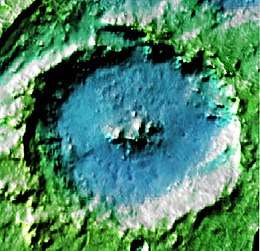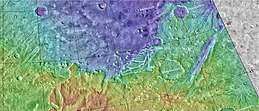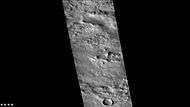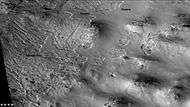Perepelkin (Martian crater)
Perepelkin Crater is an impact crater in the Arcadia quadrangle of the planet Mars. It is located at 52.8°N latitude and 64.6°W longitude. It is 77 km in diameter. It was named after Russian astronomer Yevgeny Perepyolkin.[1]
 Topographic image of Perepelkin Crater | |
| Planet | Mars |
|---|---|
| Region | Arcadia quadrangle |
| Coordinates | 52.8°N 64.6°W |
| Diameter | 77 km |
| Eponym | Yevgeny Perepyolkin |

Description
Much of the crater is covered with a mantle that is believed to be ice-rich and to have fallen from the atmosphere when the climate was different. In one of the images below mantle can be seen; also some places when the mantle has disappeared, channels are visible.
Mantle
Researchers have noticed a smooth mantle covering much of Mars.[2] Some parts are eroded revealing rough surfaces while others possess layers. It’s generally accepted that mantle is ice-rich dust that fell from the sky as snow and ice-coated dust grains during a different climate [3] One evidence of its ice-rich nature is the presence of gullies which form when some of the ice melts.[4][5][6] Only a few hours of flow can result in erosion .[7] In higher latitudes, such as around Milankovic Crater, the mantle is thicker and may contain rounded shapes called scallops .[8] These are thought to be caused by the sublimation of ice in the mantle. Several models have been advanced to explain them; some include a small amount of melting at times.[9][10][11][12]
 Perepelkin Crater, as seen by CTX camera (on Mars Reconnaissance Orbiter).
Perepelkin Crater, as seen by CTX camera (on Mars Reconnaissance Orbiter). Channels and mantle, as seen by CTX camera (on Mars Reconnaissance Orbiter). Channels are exposed where the mantle has disappeared.
Channels and mantle, as seen by CTX camera (on Mars Reconnaissance Orbiter). Channels are exposed where the mantle has disappeared.
See also
References
- "Gazetteer of Planetary Nomenclature | Perepelkin". usgs.gov. International Astronomical Union. Retrieved 4 March 2015.
- Mustard, J., C. Cooper, M. Rifkin. 2001. Evidence for recent climate change on Mars from the identification of youthful near-surface ground ice. Nature 412, 411–414 .
- Pollack, J., D. Colburn, F. Flaser, R. Kahn, C. Carson, and D. Pidek. 1979. Properties and effects of dust suspended in the martian atmosphere. J. Geophys. Res. 84, 2929-2945.
- Raack, J., D. Reiss, and H. Hiesinger. 2012. Gullies and their relationships to the dust-ice mantle in the northwestern Argyre Basin, Mars. Icarus 219, 129-141.
- Schon, S. and J. Head. 2011. OBSERVATIONS OF GULLY DEVELOPMENT IN GASA – A RAYED CRATER. 42nd Lunar and Planetary Science Conference 2546.pdf
- Schon, S. and J. Head. 2012. Gasa impact crater, Mars: Very young gullies formed from impact into latitude-dependent mantle and debris-covered glacier deposits? Icarus 218, 459–477.
- Dickson, J., and J. Head. 2009. The formation and evolution of youthful gullies on Mars: Gullies as the late-stage phase of Mars’ most recent ice age. Icarus 204, 63–86.
- Lefort, A., P. Russell, N. Thomas, A. McEwen, C. Dundas, R. Kirk. 2009. Scalloped terrains in the Peneus and Amphitrites Patera region of Mars as observed by HiRISE. Icarus 205, 259-268.
- Soare, R., J. Kargel, G. Osinski, F. Costard. 2007. Thermokarst processes and the origin of crater-rim gullies in Utopia and western Elysium Planitia. Icarus 191, 95-112.
- Lefort, A., P. Russell, N. Thomas, A. McEwen, C. Dundas, R. Kirk. 2009. Scalloped terrains in the Peneus and Amphitrites Patera region of Mars as observed by HiRISE. Icarus 205, 259-268
- Ulrich, R., T. Kral, C. Chevrier, R. Pilgrim, L. Roe. 2010. Dynamic temperature fields under Mars landing sites and implications for supporting microbial life. Astrobiology 10, 643-650.
- Soare, R. and G. Osinski. 2009. Stratigraphical evidence of late Amazonian perglaciation and glaciation in the Astapus Colles region of Mars. Icarus 202, 17-21